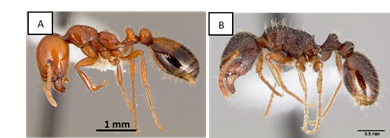Kris Tollerup, UCCE Area-wide IPM Advisor, Kearney Ag Research Center
USDA-NASS has estimated a three billion pound almond crop this year, with set so heavy that many trees are even breaking scaffolds. The size of this year’s crop will likely translate into longer periods of almonds sitting on the orchard floor waiting for pick up – especially for growers that depend on contract harvesters. Because the percentage of ant damage is related to how long the nuts remain on the orchard floor (Table 1), planning for ant management this season is vital.
Table 1. Percent damage by Southern Fire Ants to almonds on the ground, shows the longer nuts are on the ground, the higher the ant damage. The paramount concern is direct feeding damage to the nut meat caused by the southern fire ant, Solenopsis xyloni, and pavement ant, Tetramorium immigrans (Fig. 1) while the crop is on the orchard floor during harvest. There are roughly 10 other ant species that often occur in almond orchards but pose no economic threat to the crop. Some very common species include the native gray ant, Formica aerate, pyramid ant, Monomorium bicolor, and California harvester ant, Pogonomyrmex californicus. The food sources of the native gray and pyramid ant consists of small insects and arthropods, and when available, honeydew. The harvester ant feeds exclusively on small seeds.
The paramount concern is direct feeding damage to the nut meat caused by the southern fire ant, Solenopsis xyloni, and pavement ant, Tetramorium immigrans (Fig. 1) while the crop is on the orchard floor during harvest. There are roughly 10 other ant species that often occur in almond orchards but pose no economic threat to the crop. Some very common species include the native gray ant, Formica aerate, pyramid ant, Monomorium bicolor, and California harvester ant, Pogonomyrmex californicus. The food sources of the native gray and pyramid ant consists of small insects and arthropods, and when available, honeydew. The harvester ant feeds exclusively on small seeds.
Because both pest and non-pest ant species so commonly exist in the same orchard, monitoring and proper identification play an important role in efficient ant management. The University of California Statewide Integrated Pest Management (IPM) Program Almond Pest Management Guidelines provides a procedure for monitoring pest ants in almond. The Pest Management Guidelines suggests that monitoring begins during April and May in the southern San Joaquin Valley and early June in the northern San Joaquin Valley and Sacramento Valley region. The mean number of pest ant nest openings is determined in five survey areas of ~1,000 ft2 per survey area, per orchard. The guidelines provide a form and table to aid in recording sampling results and management decisions.
For instance, the table provided by the Pest Management Guidelines (Table 1.) indicate that if there are 15 nests per 5000 ft2, and nuts remain on the ground for seven days, approximately 1.6% damage could result. Moreover, if nuts remain on the orchard floor for up to 10 days, 2.1% damage can occur.
So, what to do? Importantly, differentiate between pest and non-pest ant species. This is important since the insecticide baits effective against the pest species do not affect non-pests. In other words, do not assess a bait treatment as ineffective by misidentifying the target species. Next, monitor for pest ants and make sure there are enough to justify a treatment.
Four very effective bait management options exist for almond: insect growth regulator (IGR) baits, Esteem (pyrproxyfen), and Extinguish (methoprene), and stomach poison baits, clinch (abamectin) and Altrevin (metaflumizone). Each of these baits use soybean oil as the attractant / toxicant carrier and preferentially attract lipid-feeding (protein-feeding) ants. When deciding on a management strategy, make sure to consider the lag time between bait application and population reduction. IGR baits work slower, taking up to eight weeks before affecting a significant reduction in foraging activity. At this time in the season, an IGR ant bait may not be the best choice for the earlier-harvested cultivars. In contrast, the stomach toxicants, abamectin and metaflumizone work much faster, requiring just three and one week, respectively, before significantly reducing foraging activity.
Ant bait is relatively inexpensive and, when used properly, can save a grower a lot of money. Apply bait to dry soil that will not be irrigated for 48 hours by sprinkler. The bait can absorb moisture from soil or irrigation water and is then less attractive to ants. Don’t use bait from bags open for more than a week. The soybean oil rapidly spoils and rancid soybean oil is not attractive to ants. Buy bait and use it quickly for best results.
Insecticide use should occur only if monitoring indicates the presence of ant pests. Apply bait insecticides only after considering the potential risks of the compound to water quality. For more information on this and other topics please consult the UC IPM Pest Management Guidelines for Almonds.

Fig. 1. Southern fire ant, Solenopsis xyloni (A) and Pavement ant, Tetramorium immigrans. Picture by April Nobile. AntWeb. Version 8.34. California Academy of Science. Accessed 12 June 2020.


Leave a Reply